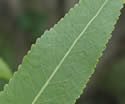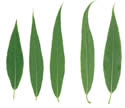Salix nigra (Black Willow)
| Also known as: | |
|---|---|
| Genus: | Salix |
| Family: | Salicaceae (Willow) |
| Life cycle: | perennial woody |
| Origin: | native |
| Habitat: | sun; wet; shores, river banks, floodplains, swamps, marshes, swales, wet meadows, wet ditches |
| Bloom season: | May - June |
| Plant height: | 15 to 80 feet |
| Wetland Indicator Status: | GP: FACW MW: OBL NCNE: OBL |
| MN county distribution (click map to enlarge): |  |
| National distribution (click map to enlarge): |  |
Pick an image for a larger view. See the glossary for icon descriptions.
Detailed Information
Flower: 

![[photo of male catkins ©Judy Gallagher]](/udata/r9ndp23q/contrib/salix-nigra_39006964211jg-t.jpg) Male and female flowers are on separate plants (dioecious) in spike-like clusters (catkins) at the tips of short branchlets along 1 year old branches, emerging with or just after the leaves. Male catkins are 2/3 to 3 inches long, the flowers crowded, each flower with 4 to 6 yellow-tipped stamens that have a few hairs on the lower half of the stamen stalk (filament).
Male and female flowers are on separate plants (dioecious) in spike-like clusters (catkins) at the tips of short branchlets along 1 year old branches, emerging with or just after the leaves. Male catkins are 2/3 to 3 inches long, the flowers crowded, each flower with 4 to 6 yellow-tipped stamens that have a few hairs on the lower half of the stamen stalk (filament).
![[photo of female catkins]](/udata/r9ndp23q/trees/salix-nigra-black-willow_0517_204352-t.jpg) Female catkins are slender, 1 to 3 inches long, the flowers somewhat loosely arranged on the spike, narrowly pear to bottle-shaped with a long beak, hairless, and on slender stalks .5 to 1.5 mm long. At the base of each male and female flower stalk is a yellowish scale-like bract covered with wavy hairs. The bracts drop off as fruit develops.
Female catkins are slender, 1 to 3 inches long, the flowers somewhat loosely arranged on the spike, narrowly pear to bottle-shaped with a long beak, hairless, and on slender stalks .5 to 1.5 mm long. At the base of each male and female flower stalk is a yellowish scale-like bract covered with wavy hairs. The bracts drop off as fruit develops.
Leaves and stems: 

![[photo of leaves]](/udata/r9ndp23q/pd3/salix-nigra-754389-3-t.jpg) Leaves are alternate, 2 to 6 inches long, to ¾ inches wide, 5 to 13 times as long as wide, narrowly lance-elliptic, widest below or near the middle, wedge-shaped to somewhat rounded at the base, with a long taper to a pointed tip, often with a slender, tail-like extension at the tip. The upper surface is dull to slightly glossy, medium to dark green, the lower surface dull and about the same color. Edges are finely toothed.
Leaves are alternate, 2 to 6 inches long, to ¾ inches wide, 5 to 13 times as long as wide, narrowly lance-elliptic, widest below or near the middle, wedge-shaped to somewhat rounded at the base, with a long taper to a pointed tip, often with a slender, tail-like extension at the tip. The upper surface is dull to slightly glossy, medium to dark green, the lower surface dull and about the same color. Edges are finely toothed.
![[photo of stipules]](/udata/r9ndp23q/pd3/salix-nigra-894385093-1-t.jpg) At the base of the leaf stalk is usually a pair of small leaf-like appendages (stipules), rounded to pointed at the tip, but often absent on early leaves. A pair of small, round glands are commonly at the tip of the leaf stalk but may require magnification to see. New leaves are green, sparsely to moderately covered in crinkled, white and sometimes rusty-colored hairs on both surfaces; some hairs may persist on the lower surface and along the midvein especially near the leaf stalk. New branchlets are hairless to somewhat hairy, yellowish to greenish turning brown to red-brown the second year.
At the base of the leaf stalk is usually a pair of small leaf-like appendages (stipules), rounded to pointed at the tip, but often absent on early leaves. A pair of small, round glands are commonly at the tip of the leaf stalk but may require magnification to see. New leaves are green, sparsely to moderately covered in crinkled, white and sometimes rusty-colored hairs on both surfaces; some hairs may persist on the lower surface and along the midvein especially near the leaf stalk. New branchlets are hairless to somewhat hairy, yellowish to greenish turning brown to red-brown the second year.
![[photo of mature trunks]](/udata/r9ndp23q/pd3/salix-nigra-14-5-t.jpg) Older bark is gray, furrowed with flat ridges. Trunks are single or a few in a clump, erect to leaning or even prostrate, and can reach 20 inches diameter at breast height (dbh).
Older bark is gray, furrowed with flat ridges. Trunks are single or a few in a clump, erect to leaning or even prostrate, and can reach 20 inches diameter at breast height (dbh).
Fruit: 
![[photo of fruit]](/udata/r9ndp23q/trees/salix-nigra-black-willow_0607_080617-t.jpg) The spike elongates some as fruit matures, the fruit becoming more loosely arranged than the flowers.
The spike elongates some as fruit matures, the fruit becoming more loosely arranged than the flowers.
![[photo of capsule and scale]](/udata/r9ndp23q/trees/salix-nigra-060719-s4-t.jpg) Fruit is a capsule 3 to 5 mm long, yellowish when mature, hairless, pear-shaped, inflated at the base with a long beak. The capsule splits into two halves when mature, releasing the cottony seed.
Fruit is a capsule 3 to 5 mm long, yellowish when mature, hairless, pear-shaped, inflated at the base with a long beak. The capsule splits into two halves when mature, releasing the cottony seed.
Notes:
There are over 20 species of Willows in Minnesota; Black Willow is a common native Willow, found in a variety of moist to wet places, especially areas prone to seasonal flooding such as lake shores and river banks, and can take the form of a large shrub or tree. It is recognized by the finely toothed, narrowly lance-elliptic leaves 2 to 6 inches long, usually with a long taper to a slender tip, and about the same color green on both surfaces; new leaves usually covered in crinkly hairs, sometimes the hairs persisting; leaf-stalks often have a pair of small glands at the tip near the blade; hairless capsules 3 to 5 mm long on stalks up to 1.5 mm long; male flowers have 4 to 6 stamens with a few hairs on the lower part of the filament. Catkins emerge with or just after the leaves and are subtended by a yellowish bract covered in wavy hairs; the bracts fall off as fruit develops. Stipules are present at least on later leaves. Branches are brittle at the base and tend to break off during storms.
All of Minnesota's tree Willows have similarly shaped leaves but all of the others are pale green or blue-green on the underside, where Black Willow is about the same color on both surfaces. The two natives—Peach-leaved Willow (Salix amygdaloides) and Black Willow—both have crinkly hairs on new leaves; the non-natives—Crack Willow (Salix X fragilis) and Bay Willow (Salix pentandra)—have new leaves that are hairless or with straight, silky hairs. Black Willow has been known to hybridize with Peach-leaved and a few other Willows, but no hybrids have been recorded in Minnesota.
Native Plant Nurseries, Restoration and Landscaping Services ↓
More photos
 Black Willow tree
Black Willow tree Black Willow tree
Black Willow tree Black Willow trees
Black Willow trees Black Willow shrub
Black Willow shrub leaf lower surface is the same color as upper surface
leaf lower surface is the same color as upper surface new leaves have crinkly hairs
new leaves have crinkly hairs glands at the tip of the leaf stalk are not always obvious
glands at the tip of the leaf stalk are not always obvious leaf scan
leaf scan
Photos by K. Chayka taken in Anoka County. Photos by Peter M. Dziuk taken in Anoka, Dakota and Winona counties. Salix nigra male catkins by Judy Gallagher, via Wikimedia Commons, used under CC BY 2.0
Comments
Have you seen this plant in Minnesota, or have any other comments about it?
on: 2020-06-16 15:51:47
We have discovered several 6 ft tall black willow trees in the wetlands behind our home. Are they an invasive species?
on: 2020-06-16 17:53:35
Pam, your black willows are right where they are supposed to be, in a native wetland. Leave them be.
on: 2020-08-15 19:18:19
Saw them in abundance at the Frog Pond near the Jensen Lake Trailhead.
on: 2022-05-15 10:57:04
We have several Black Willows on our property in wetland along the East Fork of the Des Moines River, but they aren't listed as being in Martin County. The first image here is identical to what I am seeing on the trees now. Is there a way to verify or document this?
on: 2022-05-15 16:36:47
Dawn, the distribution maps only reflect what's been previously recorded. There will always be gaps in the records, since not every inch of every county can be surveyed. The best way to update the records is to submit a specimen to the Bell Herbarium, then it becomes part of the official record, but you will need to confirm the ID first. You can post some images on the Minnesota Wildflowers facebook page.






